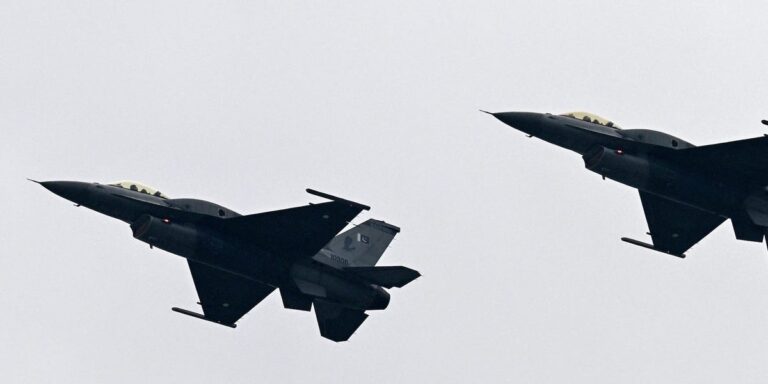- Analysts believe Pakistan may equip its JF-17 fighter jets with nuclear-tipped cruise missiles.
- Suspicion that the JF-17 might be equipped with nuclear missiles remained merely speculation until recent photographs were released.
- India and Pakistan have fought four wars and clashed repeatedly along their border.
The balance of nuclear terror between the US and Russia, and now between the US and China, is what worries most about nuclear apocalypse, but the simmering conflict between India and Pakistan (both nuclear powers) is just as dangerous.
There are now indications that Pakistan is equipping its JF-17 fighter jets with nuclear-capable cruise missiles, which the Federation of American Scientists says are intended to replace the aging French-made Mirage fighter jets Pakistan currently uses in the nuclear strike role.
“These developments, combined with rising tensions in the region, raise concerns about an accelerating arms race and new risks of a potential escalation of conflict between India and Pakistan, especially as India is also expanding the size and capabilities of its nuclear arsenal,” FAS analyst Eliana Johns wrote.
Given the secrecy surrounding Pakistan’s nuclear program, it’s not surprising that evidence that the JF-17 is carrying nuclear weapons is only circumstantial. Pakistan’s current nuclear strike aircraft are the 1960s-era Mirage V, which is equipped with a nuclear bomb, and the Mirage III, which has been tested with Raad cruise missiles, which can be equipped with nuclear or conventional warheads. Recently, a JF-17 was photographed in flight carrying what appears to be the Raad missile.
However, the Pakistan Air Force does have at least 130 JF-17 Thunders, a joint Pakistan-China project to develop a fighter jet equivalent to the U.S. F-16 (Pakistan also operates 75 F-16s). Designated FC-1 Xiaolong (Fighting Dragon) by the Chinese military, the aircraft made its first flight in 2003.
Suspicions that the JF-17 might be carrying Ra’ad missiles remained largely speculation until photographs recently surfaced. “During a rehearsal for the (since cancelled) 2023 Pakistan Day Parade, images emerged showing a JF-17 Thunder Block II carrying what was said to be a Ra’ad ALCM,” according to FAS. “Notably, this was the first time such a configuration had been publicly observed.”
The Federation of American Scientists “purchased the original imagery” and compared the Ra’ad aboard the JF-17 with earlier images. One question is which version of the Ra’ad was aboard the JF-17. According to the CSIS Missile Threat Defense site, the Ra’ad I (also known as the Hatf-8) is a subsonic air-launched cruise missile with an estimated range of over 200 miles, comparable to other models such as the European Storm Shadow. The newer Ra’ad II reportedly has a range of almost 400 miles. Pakistan is also developing an anti-ship version of the Ra’ad, the Taimoor.
After analyzing the images using tools such as Photoshop Vanishing Point, the FAS concluded that the JF-17 was armed with an older model Ra’ad I. If true, this would put numerous targets in western and northern India within range of the missiles’ nuclear and conventional cruise missiles.
“Pakistan has several airbases close to the border,” Johns told Business Insider. “The aircraft could be scrambled to disperse bases within the Pakistani border if necessary and approach potential targets inside India at ranges of 350-600 kilometers.”
There is still a great deal of uncertainty about the Ra’ad’s exact capabilities. “Looking at the differences between the Ra’ad I and Ra’ad II missiles raises several questions,” FAS noted. “How has Pakistan managed to nearly double the Ra’ad’s range from an estimated 350 km to 550 km, and even 600 km in the latest version, without significantly changing the missile’s size to accommodate a larger fuel load? The answer could be that the Ra’ad II’s engine design is more efficient, structural components are made from lighter materials, or the payload has been reduced.”
So for now, Pakistan’s air-launched cruise missile capability remains a mystery. “It is unclear whether either of the Ra’ad systems have been deployed, but this is a matter of when, not if,” FAS said. “Once deployed, it remains to be seen whether Pakistan will also continue to retain an aircraft-based nuclear gravity bomb capability or move exclusively to stand-off cruise missiles.”
Although the JF-17 is a joint Chinese-Pakistani development, Johns doesn’t believe China will try to prevent Pakistan from converting it into a nuclear strike aircraft. “China and Pakistan have enjoyed a long-standing economic and technological partnership,” Johns said. “Pakistan appears to have received its first nuclear weapon blueprints from China. The JF-17 was not built for the Chinese air force’s nuclear mission. However, with its aging Mirage III and V aircraft, Pakistan appears to be preparing the aircraft for a nuclear strike capability.”
Ballistic missiles will remain the primary delivery vehicle for Pakistan’s estimated 170 nuclear weapons, including at least six types of mobile rockets. But extending the range of Pakistan’s airborne nuclear arsenal will only exacerbate the possibility of nuclear war. Both Pakistan and India are already developing multiple inertial revolved (MIRV) ballistic missiles, and Pakistan is working on developing shorter-range dual-use ballistic missiles. India and Pakistan have fought four wars and numerous border clashes since the Indian subcontinent was partitioned in 1947. In 2019, Pakistan made nuclear threats after Indian aircraft bombed militant bases in Pakistan’s Kashmir.
“In these circumstances, greater transparency and understanding of the quality and intent of each country’s nuclear program is needed to prevent misunderstandings and misinterpretations,” Johns concluded.
Michael Peck is a defense writer whose work has appeared in Forbes, Defense News, Foreign Policy and other publications. He holds a Master’s in Political Science from Rutgers University. twitter and LinkedIn.

